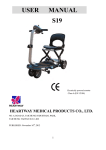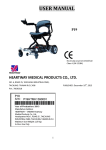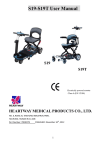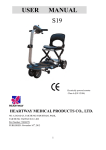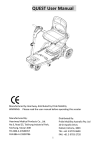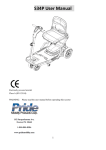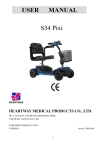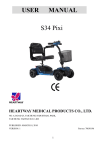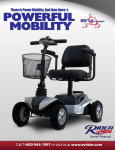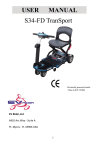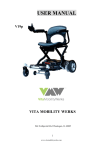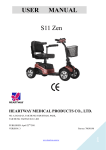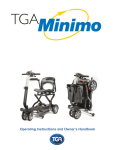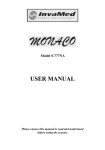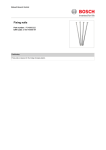Download USER MANUAL P19
Transcript
USER MANUAL P19 Electrically powered scooter Class A (EN 12184) HEARTWAY MEDICAL PRODUCTS CO., LTD. NO. 6, ROAD 25, TAICHUNG INDUSTRIAL PARK, TAICHUNG. TAIWAN R.O.C.408 Part Number: 70030279 PUBLISHED: November 16th, 2012 1 CONTENTS 1. SAFETY INSTRUCTION…………...……………………………………………………...……………................................…3 2. ELECTOMAGNETIC INTERFERENCE(EMI)…………………………………………..……….…………………………………7 3. TECHNICAL SPECIFICATION…….…….………………..……………………………………………………….…………………..8 4. ADJUSTMENT……………………………………………………………………………………………………………………..…..……9 5. OPERATION OF CONTROL PANEL………………………………………………………….................……………………..10 6. BATTERYA AND CHARGING INSTRUDCTION….…………………………………………………………………….…..…12 7. MAINTENANCE & REPAIR…..……………….………...………………….……………………………………………..……..…14 8. TROUBLESHOOTING & FAULT REPAIR……….………..………………………………………………………………………15 9. BOM LIST DRAWING………………............…………………….………….……………………………………………………16 10. WARRANTY DECLARATION…………………………………………………………………………………………………………17 2 SAFETY INSTRUCTION General Always use a seat belt, and keep your feet on the Never operate the scooter while you are under the influence of alcohol. scooter all the time. Never use electronic radio transmitters such as walkie-talkies, or cellular phones. Make sure that there are no obstacles behind you while reserving your scooter. Do not make a sharp turn or a sudden stop while riding your scooter. Do not rider your scooter in traffic. 3 Do not attempt to climb curbs greater than limitation show on Technical Specification Do not leave your hands and legs off the scooter when driving. Do not rider your scooter during snow in order to avoid accident on slippery road. Do not allow unsupervised children to play near this equipment while the batteries are charging. Warning – Don’t operate your scooter for the first time without completely reading and understanding this user manual. 1. Don’t operate scooter on public streets and roadways. Be aware that it may be difficult for traffic to see you when you are seated on the scooter. Obey all local pedestrian traffic rules. Wait until your path is clear of traffic, and then proceed with extreme cautions. 2. To prevent injury to yourself or others, always ensure that the power is switched off when getting on or off of the scooter. 3. Always check that the drive wheels are engaged (drive mode) before driving. Do not switch off the power when the scooter is still moving forward. This will bring the chair to an extremely abrupt stop. 4. Do not use this product or any available optional equipment without first completely reading and understanding these instructions. If you are unable to understand the warnings, cautions or instructions, contact a healthcare professional, the dealers or technical supports before attempting to use this equipment, otherwise, injury or damage may occur. 5. There are certain situations, including some medical conditions, where the scooter user will need to practice operating the scooter in the presence of a trained attendant. A trained attendant can be defined as a family member or care professional especially trained in assisting a scooter user in various daily living activities. Consult with your physician if you are taking any medication that may affect your ability 4 to operate your scooter safely. 6. Do not attempt to lift or move a power scooter by any of its removable parts including the armrests, seats or shrouds. Personal injury and damage to the power chair may result. 7. Never try to use your scooter beyond its limitations as described in this manual. 8. Please do not sit on your scooter while it is in a moving vehicle. 9. Keep your hands away from the wheels (tires) while driving scooters. Be aware that loose fitting clothing can become caught in the drive tires. 10. Consult your physician if you are taking prescribed medication or if you have any certain physical limitations. Some medications and limitations may impair your ability to operate scooters in a safe manner. 11. Be aware when the drive mode is unlocked or locked. 12. Don’t remove anti-tipper if there is any-tipper equipped with the scooter. 13. Contact with tools can cause electrical shock and do not connect an extension cord to the AC/DC converter or the battery charger. 14. Do not attempt to lift or move your scooter by any of its removal parts, such as the armrests, seats, or shroud. 15. When climbing an incline, don’t drive at an angle up the face of the incline. Drive your scooter straight up the incline. This greatly reduces the possibility of a tip or a fall. 16. Don’t climb a slope steeper than the scooter’s limitation. 17. Don’t attempt to have your scooter proceed backward down any step, curb or other obstacle. This may cause the scooter to fall or tip. 18. Always reduce your speed and maintain a stable center of gravity when cornering sharply. Don’t corner sharply when driving scooters at higher speeds. 19. Operating in rain, snow, salt, mist conditions and on icy or slippery surfaces may have an adverse affect on the electrical system. 20. Never sit on your scooter when it is being used in connection with any type of lift or elevation product. Your scooter is not designed with such use in mind and any damage or injury incurred from such use is not the responsibility of Heartway. 21. Surfaces of the power scooter that can come into direct contact with the occupant’s skin and/or assistant’s skin during normal use and that are within occupant reach shall not exceed 41 °C. The motor surface can reach temperatures greater than 41°C after driving. Do not touch these parts when disassembling the scooter or wait until the motor is cooled down. 22. The programming of the controller shall only be carried out by personnel, which is authorized by his manufacturer. A wrong programming can result in safety hazards for the occupant! 23. If the power scooter is switched off while driving on the horizontal at maximum speed at 7 km/h, it will come to a stop with the maximum stopping distance of 1.2 m. Please consider this distance when driving. 24. Drive-wheel needs to be switched to engaged-mode while transporting the power scooter with a car or airplane. 25. Surface temperatures can increase when exposed to external sources of heat. Modifications Heartway Medical Product has designed and engineered power scooters to provide maximum utility. However, 5 under no circumstances should you modify, add, remove, or disable any part or function of your power scooter. Personal injury and damage to the power chair may result. 1. Do not modify your power scooter in any way not authorized by Heartway. Do not use accessories if they have not been tested or approved for Heartway products. 2. Get to know the feel of your power scooter and its capabilities. Heartway recommends that you perform a safety check before each use to make sure your scooter operates safely. Inspections prior to using your power scooter: 1. If equipped with pneumatic tires, please check for proper tire inflations. 2. Please check all electrical connections and make sure they are tight and not corroded. 3. Please check all harness connections and make sure they are secured properly. 4. Please check the brakes. Weight limitation. 1. Please refer to the specifications table for weight capacity information. Power scooter is rated for a maximum weight capacity. 2. Stay within the specified weight capacity for your scooter. Exceeding the weight capacity voids your warranty. Heartway will not be held responsible for injuries or property damage resulting from failure to observe weight limitations. 3. Don’t carry passengers on scooters. Carrying passengers on scooter may affect the center of gravity, resulting in a tip or a fall. Tire inflation 1. If your scooter is equipped with pneumatic tires, it is necessary to check the air pressure at least one time a week. 2. Proper inflation pressures will prolong the life your tires and ensure the smooth operation while riding. 3. Do not under-inflate or over-inflate your tires. It is critically important that 30-25 psi (2-2.4bar) tire pressure be maintained in pneumatic tires at all times. 4. Inflating your tires from an unregulated air source could over-inflate them, resulting in a burs tire. Temperature 1. Some of the parts of the power scooter are susceptible to change in temperature. The controller can only operate in temperature that ranges between -25°C ~ 50°C. 2. At extreme low temperatures, the batteries may freeze, and your power scooter may not be able to operate. In extreme high temperatures, it may operate at slower speeds due to a safety feature of the controller that prevents damage to the motors and other electrical components. 6 ELECTROMAGNETIC INTERFERENCE (EMI) The rapid development of electronics, especially in the area of communications, has saturated our environment with electromagnetic (EM) radio waves that are emitted by television, radio and communication signals. These EM wave are invisible and their strength increases as one approach the source. All electrical conductors act as antennas to the EM signals and, to varying degrees, all power wheelchairs and scooters are susceptible to electromagnetic interference (EMI). The interference could result in abnormal, unintentional movement and/or erratic control of the vehicle. The United States Food and drug Administration (FDA) suggests that the following statement be incorporated to the user’s manual for all power scooter like the P19. Power scooters may as susceptible to electromagnetic interference (EMI), which is interfering electromagnetic energy emitted from sources such as radio stations, TV stations, amateur radio (HAN) transmitter, two-way radios, cellular phones and alarm systems of shops. The interference (from radio wave sources) can cause the power scooter to release its brakes, move by itself or move in unintended directions. It can also permanently damage the powered scooter’s control system. The intensity of the EM energy can be measured in volts per meter (V/m).Each powered scooter can resist EMI up to a certain intensity. This is called “immunity level”. The higher the immunity level the greater the protection. At this time, current technology is capable of providing at least 20 V/m of immunity level, which would provide useful protection against common sources of radiated EMI. Following the warnings listed below should reduce the chance of unintended brake release or powered scooter movement that could result in serious injury: 1. Do not turn on hand-held personal communication devices such as citizens band (CB) radios and cellular phones while the powered scooter is turned on. 2. Be aware of nearby transmitters such as radio or TV stations and try to avoid coming close to them. 3. If unintended movement or brake release occurs, turn the powered scooter off as soon as it is safe. 4. Be aware that adding accessories or components, or modifying the powered scooter, may make it more susceptible to interference from radio wave sources (Note: It is difficult to evaluate the effect on the overall immunity of the powered scooter). 5. Report all incidents of unintended movement or brake release to the powered scooter manufacturer, and note whether there is a radio wave source nearby. TURN OFF YOUR POWERED SCOOTER AS SOON AS POSSIBLE WHEN EXPERIENCING THE FOLLOWING: Unintentional scooter movements Unintended or uncontrollable direction. Unexpected brake release The FDA has written to the manufacturers of power scooters asking them to test new products to be sure they provide a reasonable degree of immunity against EMI. The FDA requires that a powered wheelchair should have an immunity level at least 20 V/m, which provides a reasonable degree of protection against more common sources of EMI. The higher the immunity level the greater the protection. Your powered scooter has an immunity level of 20 V/m which should protect against common sources of EMI. Warning: The scooter itself can disturb the performance of the electromagnetic fields such as emitted by alarm systems of shops. 7 TECHNICAL SPECIFICATIONS MODEL P19 WEIGHT CAPACITY 115kgs(250 lbs) SEAT: TYPE/SIZE 16" Fish-on DRIVE WHEEL 200*50 FRONT CASTER (WHEEL) 5*1-1/2" MAX SPEED 6Km/hr BATTERY SPECIFICATIONS 24V 11.5Ah Li-Polymer (14.5 option) BATTERY RANGE 15Km CHARGER TYPE 2.5Amp,110/240 Volt,Li-ION Charger (4Amp option) CONTROLLER TYPE VR2 MOTOR TYPE 150W*2 WEIGHT: W/ BATTERY 32kg WEIGHT: W/O BATTERY 28.7Kg TURNING RADIUS 680mm SUSPENSION INDEGO SUSPENSION LENGTH 850mm WIDE 520mm HEIGHT 830mm Folded Size 800*520*420 SEAT WIDTH 410mm SEAT HEIGHT 350mm SEAT DEPTH 330mm BACK HEIGHT 360mm WHEELBASE 640mm 8 ADJUSTMENT (FOLDING PROCEDURE) It is very easy to assemble your P19 Power Wheelchair. Please follow the procedure below. P19 power wheelchair has aluminum alloy body and can be easily folded to fit in the car for transportation. It also has easy to use controls and adjustable tiller positioning. See the following steps to fold the P19 power wheelchair Pull the Red Bar Fold the Seat Backrest Pull down the seat to fold the power wheelchair until the seat locks Remove the arm-rest from the receiving port 9 OPERATION OF CONTROL PANEL The power wheelchair is simple to operate. However, we recommend that you read carefully the following instructions to become familiarized with your new vehicle. A Word of Caution: Before you turn the power on, always be aware of the environment that surrounds you to select your desired speed. For indoor environments we recommend that you select the slowest speed setting. For outdoor operation of this vehicle we recommend that you select a speed that is comfortable for you to control it safely. The following steps are required to operate your vehicle safely with the controller-can use for P19 Battery Condition LED ON/OFF HORN Speed indication Speed control Speed control Joystick (Fig 19) A. Driving: 1.Controller ON/OFF Switch Press the ON/OFF button (I/O) switch located in front of the joystick to activate your power wheelchair. The battery condition meter will light up to indicate the current charge of your battery. Pressing the ON/OFF button again will deactivate the controller. 2.Speed Control The speed control buttons allow you to set the forward speed to your desired setting. Pressing the speed-increasing button will set the speed at the faster settings while the speed will slow down if you press the speed-decreasing button. The controller sets the reverse speed, acceleration and deceleration proportionally and automatically for your safety. 3.Joystick The joystick controls the direction and speed of your vehicle, pointing the joystick away from the neutral position (center) will move the vehicle in the direction where the joystick is pointing. The farther away (forward/backward) the joystick is from the neutral position, the faster the vehicle will go. The farther away to the right/ left the joystick is pointing, the sharper the turn of the 10 vehicle will be. To operate the vehicle by gently pushing the joystick in the direction you want to go. Returning the joystick to its neutral position (center) will reduce the speed and stop the vehicle by automatically applying the electromagnetic brakes. Notes: →After pressing the controller ON/OFF switch, allows two seconds to elapse before engaging the joystick. This is a safety feature to prevent sudden start. →Gentle operation of the joystick will result in smoother transitions in speed and direction, while sharp operation of the joystick will result in drastic transitions in direction and velocity. →When the wheelchair is in operation, the surface of the charger will become slightly hot. →In case of emergency, let go of the joystick and the chair will come to a stop. B. Controller Display The controller display is a multifunction visual display. It can provide four types of information: 1. ON/OFF Status. When the power is on, the controller’s LED will be lit up. If the LED is not lit, the controller is OFF. 2. Battery Condition Meter. The battery condition meter is composed of 10 segments (three of red, four of yellow, and three of green). It enables you to monitor battery charge. The battery condition meter indicates the approximate amount of battery charge left. →Red, yellow and green LEDs indicate that the batteries are fully charged →Red and yellow LEDs indicate that you should charge the batteries if possible. →Red LEDs indicate that you should charge the batteries as soon as possible, because low battery voltage may cause your power wheelchair to become inoperative. Note: When the batteries begin to approach a discharged state, the first red LED will begin to flash slowly, reminding you that the batteries need to be charged immediately. C. Electromagnetic Brakes: Your power wheelchair comes with an Electromagnetic Brakes, i.e. an automatic magnetic disc safety brake which is also known as Fail-Safe brake. The Electro-magnetic Brakes are automatic and work when the power wheelchairs is ON but in a steady state (i.e. Joystick is released to the neutral position), even when the chair is on a slope. The Electromagnetic Brakes will also be set when-ever the power wheelchair is OFF, but the motor levers are in the engaged (vertical) position. D. Thermal Protection: Your power wheelchair controller is equipped with a safety system called thermal rollback. A built-in circuit monitors the temperature of the controller and motors, the controller reduces the motor voltage and speed of the power wheelchair. The reduction of the speed allows the electrical components to cool down. Although your power wheelchair will resume its normal speed when the temperature returns to a safe level, we recommend that you turn the power off and wait for 5 minutes before restarting to allow the components to cool down if you find that you have lost speed suddenly. 11 BATTERY & CHARGING INSTRUCTION Lead-Acid Battery We recommend that you use deep-cycle batteries that are sealed and maintenance free for your power scooter. Both sealed lead-acid (SLA) and gel cell are deep-cycle batteries and are similar in performance. Deep-cycle batteries are specifically designed to provide power, drain down, and then accept a relatively quick recharge. Lead-acid batteries should be charged as often as possible. Specification of the battery that we recommend for P19 is Type: Size: Voltage: Amp Hours: Deep –cycle sealed lead-acid or gel cell 12AH 12V each 12 amp hours Depending on the use, terrain and driving conditions, the batteries will provide a range of 15 km of travel. However, even if the power scooter is not in use, we recommend that the batteries are charged periodically. Note: Do not use any automotive batteries. They are not designed to handle a long, deep discharge and also are unsafe for use in power scooter. The useful life of a battery is quite often a reflection of the care it receives. Lithium Battery (11.5A) BATTERY CHARGER The battery charger takes the standard wall outlet voltage (alternating current) and converts it into DC voltage (direct current).The batteries use direct current to run your power scooter. When the batteries are fully charged, the amperage from the charger is almost at zero. This is how the charger maintains a charge but does not overcharge the battery. Note 1: The batteries cannot be charged if they were discharged to nearly zero voltage. Note 2: The powered scooter meet the requirement of ISO 7176-14:2008 and ISO 7176-21:2003. 12 Note 3: Only use the battery charger type 4C24050A which was provided by the scooter supplier. The use of any different type of charger can be hazardous and need the approval of the manufacturer. CHARGING INSTRUCTIONS To recharge the batteries, follow the steps below: Place your power scooter close to a standard electrical wall outlet. Remove your key to turn the power OFF Slide the charger port door open. Plug the XLR connector of the charger to the charger port. Plug the other end of power cord into a standard wall outlet. When charging is completed, battery capacity indicator is shown. Disconnect the charger power cord from the wall outlet when the batteries are fully charged. Recharge battery only when the key is in off position. Note: Always charge your batteries in well ventilated areas. The charger is intended for indoor use only. Protect from moisture. For maximum performance, it is recommended that you replace both batteries at the same time if the batteries are weak. If the vehicle will not be used for a long period of time, arrange to have the batteries recharged at least once every month to avoid deterioration of the batteries. According to the battery type and condition of the batteries, they usually can be fully charged in 4-10 hours. This will be indicated when the status light in the battery charger side panel turns green. Charging the battery longer than necessary will not harm the battery. We recommend that you charge the batteries for 8 to 10 hours after daily use. BATTERY INDICATOR A battery indicator is to provide information about the travelling range remaining. Indicator Travelling Range Remaining Full 13 km Traveling Range Remaining Green Area 7~13 km Travelling Range Remaining Yellow Area 4~7 km Travelling Range Remaining Red Area 1~4 km Travelling Range Remaining End 0 Kilometer 13 MAINTENANCE & REPAIR To keep your P19 for years of trouble-free operation, we recommend you follow the following maintenance checks as scheduled. DAILY CHECKS 1. Visual check on the conditions of tires. 2. Inspect the battery condition meter on the controller to determine if batteries need to be charged. MONTHLY CHECKS 1. Visually inspect the controller harnesses. Make sure that they are not frayed, cut or have any exposed wires. SEMI-ANNUAL CHECKS 1. Check the motor brushes. We recommended that your authorized dealer inspect the brushes every six months or sooner if your power scooter is not operating smoothly. If inspection determines excessive wear on the brushes, they must be replaced or motor damage will result. CHECKS: Make sure to keep the controller clean while protecting it from rain or water. Never hose off your power scooter or place it in direct contact with water. Keep wheels free from lint, hair, sand and carpet fibers. Visually inspect the tire tread. If less than 1mm (1/32”), please have your tires replaced by your local dealer. All upholstery can be washed with warm water and mild soap. Occasionally check the seat and back for sagging, cuts and tears. Replace if necessary. Do not store your scooter in damp or humid conditions as this will lead to mildew and rapid deterioration of the upholstery parts. All moving mechanism will benefit from simple lubrication and inspection. Lubricate using petroleum jelly or light oil. Do not use too much oil, otherwise small drips could stain and damage carpets and furnishings etc. Always perform a general inspection of the tightness of all nuts and bolts. 14 TROUBLESHOOTING & FAULT REPAIR P&G S-Drive 45 Amp controller: Your scooter is fitted with S-Drive controller, which continuously monitors the operating conditions of your scooter. If it detects a problem it will indicate with error message by flashing light on the power ON/ OFF light. You must count the number of the flash, and see the list to check what kind of error has happened according to the number) Flash Description 1 The battery needs charging or there is a bad connection to the battery. Check the connections to the battery. If the connections are good, try changing the battery 2 There is a bad connection to the motor. Check all the connections between the motor and the controller 3 The motor has a short circuit to a battery connection. Contact your service agent. 4. The freewheel switch is activated or the manual brake disengagement mechanism is operated. Check the position of the switch of lever. 5 Not used 6 The S-Drive is being inhibited from driving. Inhibit 2 is active. This may be because the battery charger is connected or the seat is no in the driving position. 7 A throttle fault is indicated. Make sure that the throttle is in the rest position before switching on the scooter. 8. A controller fault is indicated. Make sure that all connections are secured. 9. The parking brakes have a bad connection. Check the parking brake and motor connections. Make sure the controller connections are secured. 10. An excessive voltage has been applied to the controller. This is usually caused by a poor battery connection. Check the battery connections. Note: If you experience any technical problems, it is recommended that you check with your local dealer before attempting to troubleshoot on your own. The following symptoms could indicate a serious problem with your power scooter. Contact your local dealer if any of the following arises: 1. Motor noise 2. Frayed harnesses 3. Cracked or broken connectors 4. Uneven wear on any of tires 5. Jerky motion 6. Pulling to one side 7. Bent or broken wheel assemblies 8. Does not power up 9. Powers up, but does not move 15 BOM LIST 16 WARRANTY DECLARATION Quality/ Warranty Declaration Products are to be fit for purpose and of excellent quality and performance. For valid warranty claims Heartway will, at their discretion, replace/ repair/ refund items mutually agreed to be defective. Heartway’s Warranty as Following: Frame: Two-year limited warranty Controllers: One-and-a-half-year limited warranty Electronic Components and Charger: One-year limited warranty Warranty Exclusion. The following items are not covered by warranty. Motor brushes Wheel Tires Arm Pads Seat Cushion Fuses / Bulbs Tiller Cover Rear Shroud Front Shroud Batteries and Consumable part Any damage or defect of any nature occurring from the misuse, abuse of the product, improper operation or improper storage is not to be covered. The warranty is to start from the date of arrival of our products. Normally, the average lifespan of a scooter will last 5-year long. Heartway will be able to provide the spare-part support for five-year long after scooters purchased. Note: If you encounter a damaged or cracked battery; please enclose it in a plastic bag and call the local authorized dealers immediately for instructions on disposal and recycling. HEARTWAY MEDICAL PRODUCTS CO., LTD. NO. 6, ROAD 25, TAICHUNG INDUSTRIAL PARK, TAICHUNG. TAIWAN R.O.C.408 17

















